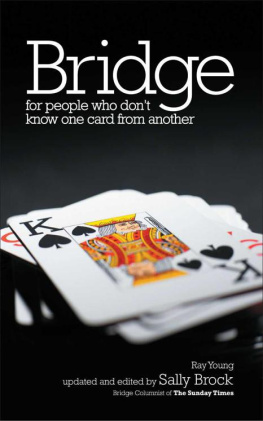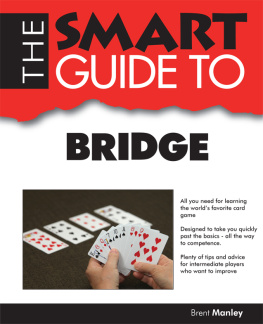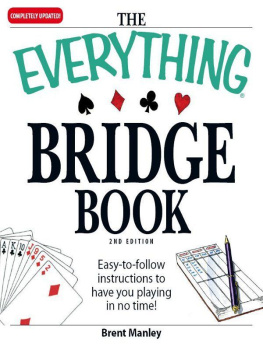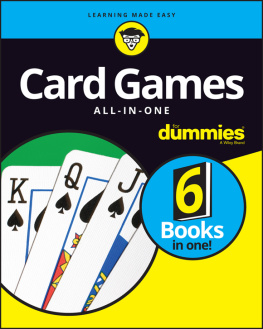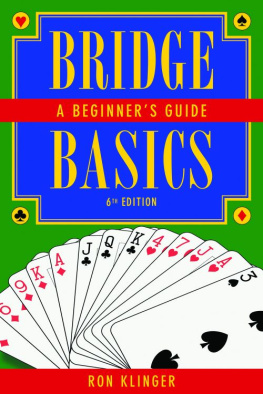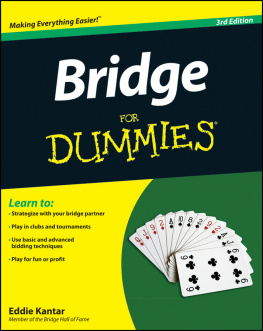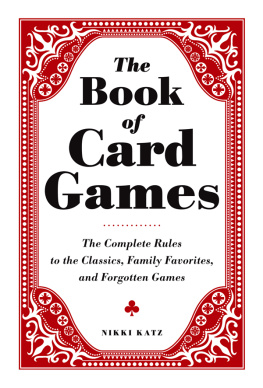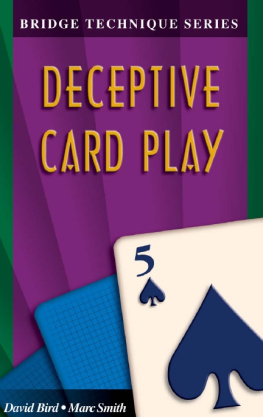
Table of Contents
Preface
Countless thousands of bright youngsters (and oldsters) deny themselves the pleasures of Contract Bridge because they think they'll appear stupid at their first lesson. Other countless thousands never get past the first page of even a basic beginners' Bridge book.
Bridge is not that hard once you leap the first hurdles, but the first hurdles can seem imposing indeed to someone who has never played a card game more complicated than Snap. The fact that there are 52 cards to keep track of seems like just too much. Complicate this further with suits and no-trumps, doubles and redoubles, and a bewildering jargon understandable only to the initiates, and the average beginner needs the courage of a lion to sit down at the Bridge table!
This book strips aside the mystery that baffles beginners. It explains all the basics that you need to know before you can play, or even read about, the game intelligently.
For best results, try to read this book all the way through in one sitting. In an hour or so you will have a good picture of what the game of Contract Bridge is all about. Then go back at your leisure and study each section. In less time and with less effort than you ever thought possible, you'll be playing Bridge, the best of all card games.
Throughout the book, players are referred to as he' rather than constantly and annoyingly repeating 'he or she', which does nothing to enhance the easy and clear communication that is the essence of this book.
Chapter 1
One Card from Another
Bridge is a card game played by four people who may sometimes shout at each other but still manage to have a lot of fun. Two are partners against the other two.
Partners sit facing each other, ideally at a smallish (about 1m/3ft) square table. This is a handy arrangement if they get cross; they can glare and holler and mutter, but the table between them keeps them from exchanging blows!
The game is played with two packs of cards, though only one pack is used at a time. There are fifty-two cards in each pack after you throw out the jokers and Bridge scoring table (on second thoughts, keep that: it might come in handy later) that come with each new pack. The pack contains four suits of thirteen cards each: spades, hearts, diamonds and clubs. The three cards in each suit are, in ascending order, the 2 (sometimes known as the deuce), 3, 4, 5, 6, 7, 8, 9, 10, jack (or knave), queen, king and ace (though there are other card games in which the ace is the lowest card). The five top cards (ace, king, queen, jack and 10) are known as honour cards.
Suits and Ranks
The most important suit - the one that has the highest rank - is spades. The word spades comes from the Spanish word espadas, meaning swords, carried only by noblemen. As you will learn later, spades can be a very noble suit indeed.

The next most important suit is hearts. This suit designation originated in France in the 16th century and is named after the shape of its symbol. You'll find later that you can make beautiful music with cards of this suit - if you have enough of them.

The next most important suit is diamonds. And this suit got its name not from diamonds but from tiles. Somebody, way back when, tilted a tile on its side and decided it looked very much like a diamond.

The least important, lowest-ranking suit of all is clubs. How this suit got its name is a mystery. The symbol for clubs is really a cloverleaf.

Spades and hearts are known as the major suits, while diamonds and clubs are the minors .
Dealing the Cards
Before you start the game, take one pack and cut for partners. Each player in turn picks up a good proportion of the pack (say between five and fifteen cards) and reveals the bottom card. The player who cuts the highest card chooses where to sit and which of two packs of cards to start playing with and also becomes dealer . If two are the same number, then the winner is the one of higher rank. The player who cuts the next highest card sits opposite him and becomes his partner. The others take the remaining two seats.
The dealer then shuffles the pack well (seven riffle-shuffles are recommended) and passes it to the player on his right for him to cut. Cut in this context means to take a fair proportion of cards, say between ten and forty, from the top of the pack, and then to put the top portion on the bottom. The purpose of this is to prevent any sharp dealer giving himself a good hand.
While this is going on, the dealer's partner shuffles the other pack and places it on his right, ready for the next deal, which will be made by the player on the dealer's left.
The dealer distributes all fifty-two cards, face down, one at a time to each player in a clockwise direction. The first person to get a card is the player to the left of the dealer. The last one to get a card is the dealer, and if the dealer has done a good job without being fumble-fingered, each person finishes up with thirteen cards. Your thirteen cards make up your hand .
Sorting your Hand
Unless you have the memory, cunning and expert card sense of a riverboat gambler, you will want to sort your thirteen cards into some kind of order. This sorting isn't hard to do at all.

Put all your cards in each suit together. You will find it easier to select your cards if you sort your suits in a red-black-red-black order, though this isn't strictly necessary. Now put all your cards in each suit in ascending order, working from right to left.

What is a Trick?
The concept of a trick occurs in many games. Each player, in clockwise order, contributes one card, and these cards form a trick. In Bridge, because each player starts with thirteen cards, there are thirteen tricks in each game.
When a particular suit is led to a trick, the other players must play a card of the same suit if they have one.
What is a Trump?
The word trump comes from a fine old Latin word triumphus, and a trump card can, indeed, triumph. One of the four suits is selected as trumps and that suit automatically ranks higher than any card in any other suit in the pack. Many games other than Bridge use trumps and the suit that is to be trumps can be selected in a number of different ways. Sometimes the dealer cuts the pack to select trumps, but in Bridge the players decide by means of the
Next page
